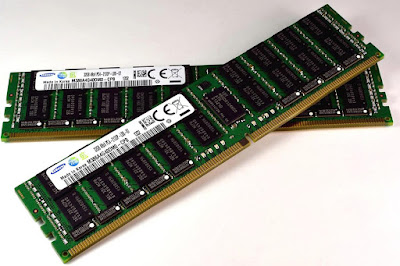Definition of Ram And Rom Memory - Random Access Memory - All data and programs entered via the input device will be stored in advance in the main memory, particularly RAM, which can be accessed randomly (can be filled / written, drawn, or delete its contents) by the program. RAM structure is divided into four main parts, namely:
Input storage, used to hold input is entered via the input device.
Program storage used to store all the instructions of the programs to be accessed.
Working storage used to store data to be processed and the processing results.
Output storage used to hold the final results of the processing of data to be displayed on the output device.
Input is entered via the input device will be accommodated first in the input storage. When the input form, the program will be moved to the storage program, and if the form data will be transferred to working storage. The results of processing are also stored in advance in the working storage and when it will be shown to the output device, the results are transferred to the output storage.
Read Only Memory (ROM)
From the name, ROM can only be read so that programmes can not fill anything into the ROM. ROM is already filled by the manufacturer in the form of an operating system consisting of basic programs required by the computer system, such as a program to regulate the appearance of the characters on the screen, filling key button keyboard for the purposes of certain controls, and a bootstrap program. The bootstrap program is required at the first computer system is activated. The process of activating the first time the computer is called the boot, which can be either cold boot or warm boot. Read What Is Internet
Cold booting a computer system to enable the process the first time to take a bootstrap program from the state of computer power off (off) to live (on). While warm booting a bootstrap program-making process repeatability while the computer is still alive by pressing the three buttons on the keyboard keys at once, ie Ctrl, Alt, and Del. This process is usually done when the system crashes, rather than having to power down the computer and turn it on again.
Instructions stored in ROM or firmware microinstruction referred to as hardware and software put together by the manufacturer. The contents of this ROM should not be lost or damaged because if it does, then the computer system will not be able to function. Therefore, to prevent the manufacturer to design such that the ROM can only be read, it can not be changed contents by others. In addition, the ROM is non-volatile so that the contents are not lost when power is turned off the computer.
In other cases is possible to change the contents of the ROM, by way of reprogramming instructions contained therein. This type of shaped chip ROM is placed in the housing which has a window in it. ROM which can be reprogrammed is a PROM (Programmable Read Only Memory), which can only be programmed once and then can not be changed back. Another type of EPROM (Erasable Programmable Read Only Memory) that can be erased with ultraviolet light and can be reprogrammed repeatedly. In addition, there is also an EEPROM (Electrically Erasable Programmable Read Only Memory) that can be erased electronically and can be reprogrammed.

Clear and concise explanation of RAM and ROM memory! Understanding these types of memory is fundamental to optimizing system performance, much like how DVHosting optimizes your website's speed and reliability.
ReplyDelete